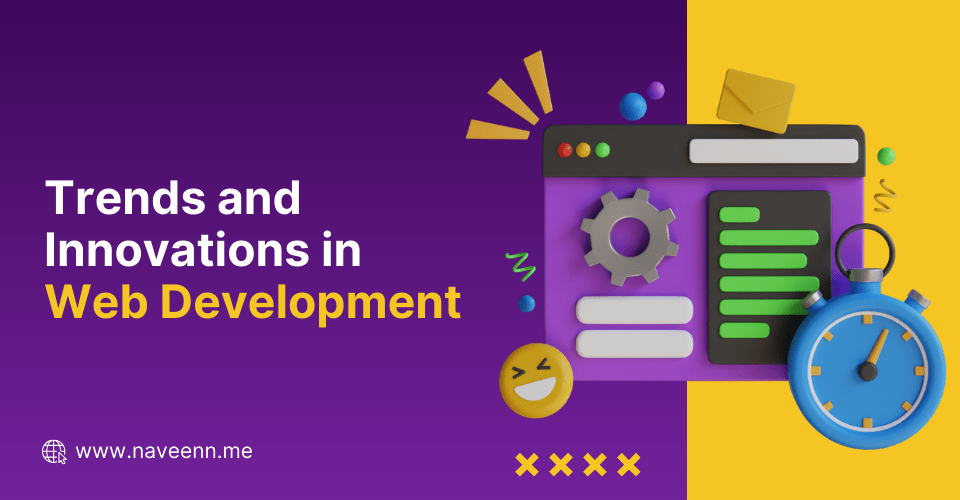In the ever-evolving landscape of web development, staying updated with the latest trends and innovations is crucial for developers and businesses alike. With technology advancing rapidly, new approaches, tools, and techniques continually reshape the way websites are built and experienced. In this blog, we’ll delve into some of the most prominent trends and innovations shaping the field of web development today.
Exploring Web Development Trends
Web development trends encompass the latest methodologies, strategies, and technologies shaping the design, construction, and enhancement of websites and web applications. These trends evolve in response to shifting user preferences, technological progress, and industry requirements.
Responsive design stands out as a pivotal facet of web development trends, ensuring seamless adaptation across diverse devices and screen dimensions. With the pervasive use of smartphones and tablets, users expect websites to offer effortless accessibility and functionality across all platforms.
Additionally, a prevalent trend in web development involves embracing a mobile-first design philosophy. This approach entails crafting websites with a primary focus on mobile devices, and then expanding functionality for larger screens. Acknowledging the ascendancy of mobile browsing, prioritizing the mobile user experience becomes imperative.
Key Web Development Trends Worth Monitoring
In the year 2024, it’s crucial for web developers and businesses to stay abreast of the latest web development trends shaping the digital realm. These trends propel the evolution of websites and applications, ensuring their relevance, engagement, and user-friendliness. From technological advancements to shifting user preferences, the web development industry undergoes constant evolution.
Responsive Web Design
Responsive design has become a standard practice in web development. As mobile device usage continues to rise, websites must seamlessly adapt to a variety of screen sizes and resolutions. Developers are leveraging frameworks like Bootstrap and Flexbox to create responsive layouts that provide optimal viewing experiences across devices.
Progressive Web Apps (PWAs)
Progressive Web Apps combine the best features of websites and mobile applications to deliver fast, engaging, and reliable user experiences. PWAs utilize service workers to enable offline functionality, push notifications, and smooth performance. Major companies like Twitter and Pinterest have adopted PWAs, highlighting their potential to revolutionize web development.
Voice Search Optimization
With the rising popularity of voice assistants like Siri and Alexa, optimizing websites for voice search has become a priority. Developers are integrating voice search capabilities into websites using natural language processing (NLP) and voice recognition technologies. By optimizing content for voice queries, businesses can enhance their visibility and accessibility in search results.
Motion UI and Micro-interactions
Motion UI and micro-interactions add dynamism and interactivity to websites, improving user engagement and usability. Developers are incorporating subtle animations, transitions, and hover effects to create visually appealing interfaces. These microinteractions delight users and provide feedback, enhancing the overall user experience.
Artificial Intelligence (AI) Integration
AI-powered tools and technologies are increasingly being integrated into web development workflows. From chatbots and virtual assistants to personalized content recommendations, AI enhances website functionality and user engagement. Machine learning algorithms analyze user behavior and preferences to deliver tailored experiences, driving conversions and customer satisfaction.
Headless CMS Architecture
Headless CMS decouples the content management system (CMS) from the frontend presentation layer, allowing developers to build flexible, customizable websites and applications. By leveraging APIs, developers can retrieve content from the CMS and deliver it to various channels and devices. Headless CMS architecture empowers developers to create highly dynamic and scalable digital experiences.
Serverless Architecture
Serverless computing empowers developers to concentrate on coding, free from the burden of server management or infrastructure concerns. Platforms like AWS Lambda and Google Cloud Functions allow developers to deploy functions as small, independent units of execution. Serverless architecture offers scalability, cost-efficiency, and reduced maintenance overhead, making it an attractive option for web development projects.
Augmented Reality (AR) and Virtual Reality (VR)
AR and VR technologies are transforming the way users interact with websites and applications. Developers are incorporating AR/VR features to create immersive experiences for e-commerce, gaming, education, and more. AR product visualization and VR tours enable users to engage with content in innovative ways, driving user engagement and brand loyalty.
Cybersecurity Measures
With cybersecurity threats on the rise, implementing robust security measures is paramount in web development. Developers are adopting HTTPS encryption, content security policies, and multi-factor authentication to protect sensitive data and prevent unauthorized access. Regular security audits and updates help mitigate risks and ensure the integrity of websites and user information.
Accessibility and Inclusivity
Designing websites with accessibility in mind is essential to ensure that all users, including those with disabilities, can access and navigate content effectively. Developers are following web content accessibility guidelines (WCAG) and implementing features such as alternative text for images, keyboard navigation, and color contrast adjustments to make websites more inclusive and user-friendly.
Read More: Best Programming Languages for Web Development
Conclusion
In conclusion, the realm of web development is experiencing swift progress fueled by emerging technologies and evolving user demands. By embracing these trends and innovations, developers can create compelling, accessible, and scalable web experiences that meet the needs of modern users. As technology continues to evolve, staying informed and adaptable will be key to staying ahead in the dynamic world of web development.

Pingback: Enhancing User Interactions through Web Portal Development